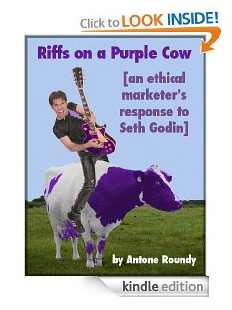Marketing Above the Noise in an Overloaded World
by Antone Roundy | 1 Comment | Mailing Lists, Marketing, Social Media/Networking, Traffic Building, Viral
Yesterday, I wrote about how to avoid information overload in a too-fast world. Today, let's talk about how to get your marketing message heard above the noise in a world where your prospects are overloaded.
Be Good Better the Best
Okay, being the best is a tall order. But at the very least, you've absolutely got to be good.
The internet is up to its eyeballs in bad information -- whether inaccurate, poorly written, or just plain useless. Content farms, article spinners, breakfast bloggers, spammers, autobloggers...the list goes on.
On a good day, bad information gets a little bit of traffic. But its visitors bounce quickly, and it doesn't get repeat traffic.
There's also lots of mediocre information out there. Yeah, it can be useful. But it doesn't fare much better than the bad, because it's so easy to find something better.
If your prospects are already overloaded, why would they subscribe to you unless they can clearly see that you're delivering value? And when they get overloaded with too much good information and start unsubscribing, what's going to keep you off the chopping block if you're not a cut above those they're dropping?
Don't be satisfied with mediocre. Make your content the best you can.
Be Consistent
There are a few ways that you need to be consistent: quality and timing.
If you occasionally put out great content, but "phone it in" the rest of the time, sure, your great content will spread, but you won't get -- or at least won't keep -- subscribers. I could give you a ton of examples of people who I've read one fantastic article from, but who never made it into my subscriptions because the rest of their content was ho-hum or worse.
Actually, I couldn't give you a ton of examples, because I don't remember who any of those people were. Their occasional exceptional content made an impression. But they didn't.
Consistent timing is also powerful. Consider this: you're subscribed to someone whose content is always top notch -- you look forward to it. But you never have any idea when they're going to publish something new. Would you say you're more or less likely to notice their new content in the torrent that flows through your in-box vs. if they were to publish something every day, or every Tuesday, or on the first of every month?
If you know when it's coming, you'll be looking for it. If you don't, the "cost" of always being on the lookout for it is probably going to be too high.
Be Different
If you're putting out the same good content as a bunch of other people, who's going to subscribe to you? People who happen to find you first. If they're already subscribed to someone else, and you don't add anything unique, then sure, you're good, but your superfluous.
Being better is one way of being different. But there are others:
- You could be more entertaining.
- You could be more focused on a particular niche. Sure, you'd appeal to a smaller group. But you'd appeal to them more strongly.
- You could mix in personal details. They may not enhance your content (just be sure they don't actively detract from it), but they may enhance the connection your audience feels with you.
- You could be more interactive. People love it when the guru comes down off the mountain to engage them personally.
- etc.
If you're different, you'll be more noticeable, and you'll appeal more strongly to anybody who likes the difference. As an added benefit, you'll be more likely to benefit from the rants of those who dislike the difference! They'll send you traffic, and some of it will stick!
Be Ubiquitous
If your prospect has given up on finding things in their overflowing email inbox, what are the odds of your reaching them through email? Pretty darned slim!
If your prospect doesn't use an RSS feed reader, what are the odds of reaching them through RSS? Pretty darned slim.
If your prospect isn't on Twitter, what are they odds they'll read your tweets? Pretty darned slim.
If your prospect never visits YouTube, doesn't have a Google+ account, doesn't visit forums, doesn't read blog comments, doesn't...
Pretty darned slim!
But if they're always on Facebook and you can get them to Like your company page, you've got a way to reach them any day of the week.
Of course, your next prospect may not be on Facebook. So you'll need an email autoresponder to reach them. And your next prospect may only be reachable through Twitter...
You need to be reaching out to prospects in as many places and through as many types of media as possible.
Obviously, that can get time consuming. For most people, it's not practical to be everywhere. So choose the places and media that appeal most to your particular audience. And design your workflow so that you can leverage content from one place and reuse it elsewhere. For example, if you're a blogger, record yourself reading your blog posts and publish them as a podcast or vodcast. And once you've written a blog post or posted a video, tweet and otherwise share a link to it.
Quick plug: my feed reader/blogging tool SEO Content Factory makes it really easy to blog (to WordPress, Blogger, Tumblr and Posterous, with more to come) and tweet from the same place. Use a tool like that to spread your content further faster.
One final tip for being ubiquitous: be sure to cross promote yourself. Make sure your blog links prominently to your Twitter, Facebook, Google Plus, YouTube, and other accounts, and that it's easy to get on your mailing list from your blog. And in all those places, link back to your blog and to the others. That way, no matter how someone first finds you, they'll be able to subscribe to you using the method they prefer -- the one where they're most likely to hear when you say something new.
Go Viral
Your prospects may not be listening to you yet. But they are listening to somebody. If you can get that somebody to talk about you, you're in. For more about how to make your content viral, see what drives word of mouth advertising and designing content to go viral.
Create a Quiet Place
My last tip for today is to see if you can get your audience to consume your content at a place or time when their are as few distractions as possible. Part of the power of video is that it engages both the eyes and the ears. If either remains unengaged, it may wander off to something else.
Live video is even better, because you know that you can't rewind if you get distracted. Interactive video is the best (like Hangouts in Google Plus), because the audience isn't just engaged -- they're involved.
Another technique some marketers have used is to create a print publication and mail it to their customers. That pulls them away from the distractions of the computer and engages them physically. More expensive, yes. But it may be worth considering.
Offline events are another powerful option, especially if you have lots of prospects living nearby. Maximum engagement and minimum distraction (at least if you can get people to turn off their smartphones!)
That'll wrap it up for today. Please share your thoughts and insights -- I'm sure there are plenty of ideas that I've missed. On Monday, I'll continue up this topic with a related post about curation blogging.





September 23rd, 2012 at 9:08 pm
I think going viral or somehow becoming the subject of word of mouth promotions is the key to getting heard above the noise, or somehow just making yourself popular on forums. There is so much junk out there and there are times when I actually get tired of reading it and trying to find what I'm looking for. I remember, I used to be really into wearing hair weaves a few years back and used to go on the hair forums all the time and there was this woman on them named Sherrie, I think. She was always there to answer questions. She also sold glue, tracks and other stuff that you needed. My philosophy was, if the beauty supply store didn't have it, or Sherrie didn't have it, only then would I go somewhere else. That's powerful, and in a niche like hair extensions, it's amazing to rise to the top like that.